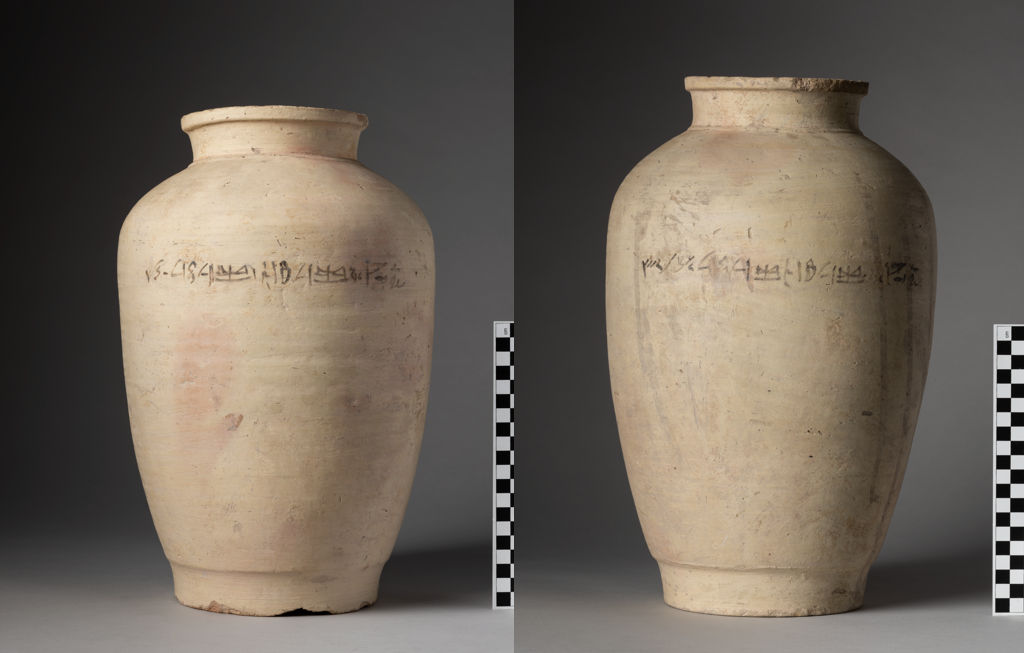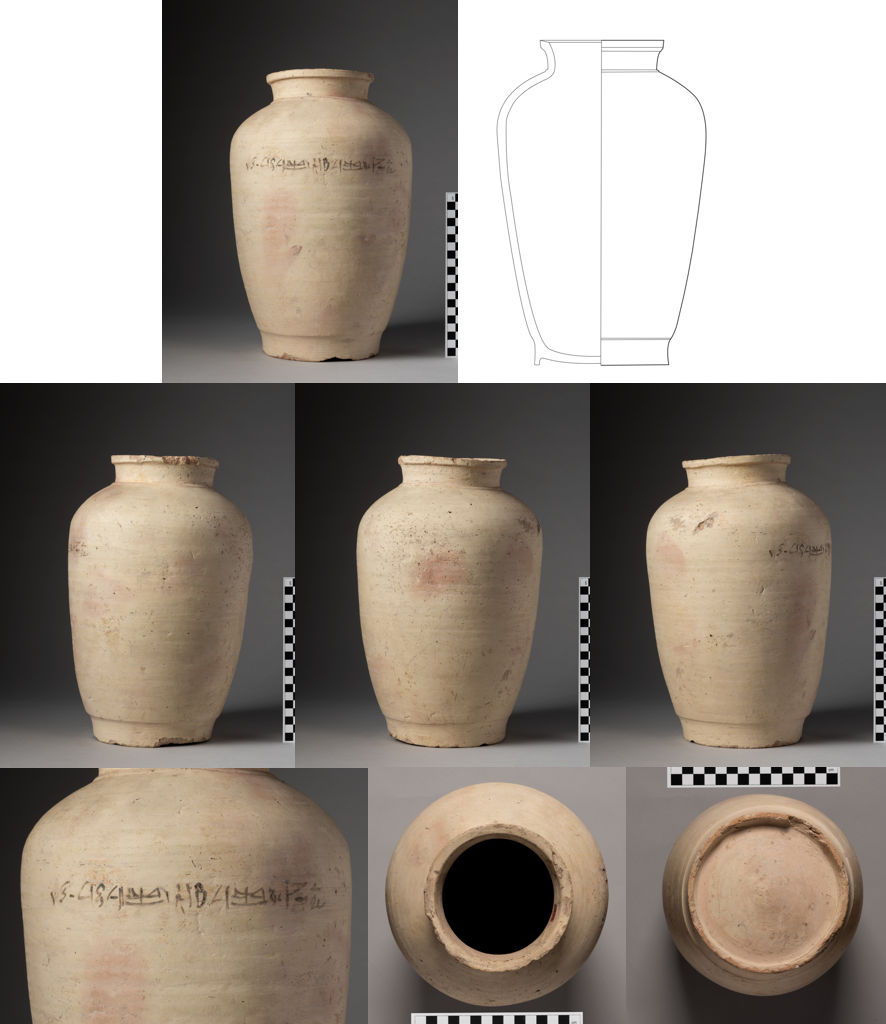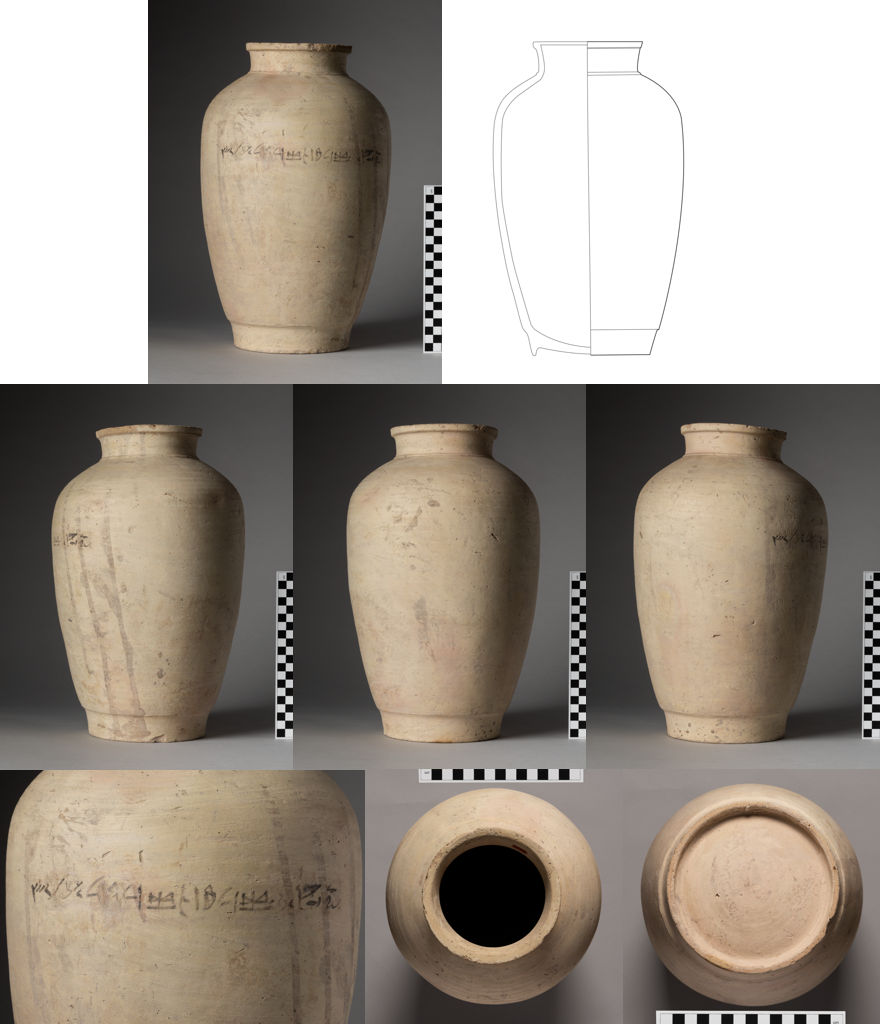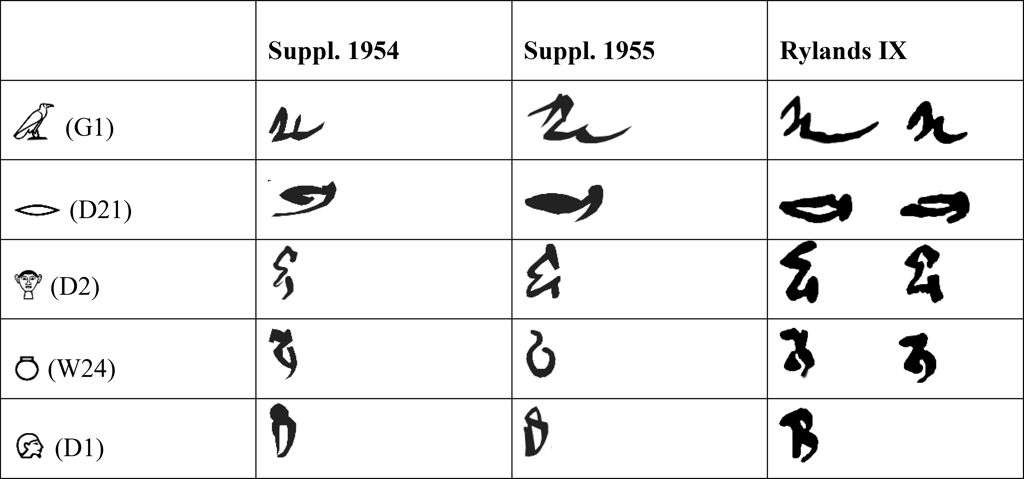Abstract
The Museo Egizio in Turin holds numerous artefacts found at Giza during archaeological excavations conducted by Ernesto Schiaparelli in February 1903. Among the material from the Late Period, two clay vases stand out because they carry a hieratic inscription. They were most likely used as containers for remains of the embalming process, stored in one of the so-called “embalming caches” that are found in Late Period funerary contexts. Many vessels with hieratic and Demotic inscriptions have come to light at Giza, Abusir, Saqqara and Thebes, but none that is published bears an inscription similar to that of these two Turin vessels. The aim of this contribution is to draw attention to these objects and their – so far unattested – inscriptions to give researchers working on embalming material and its archaeological context further study material.
The Museo Egizio holds numerous artefacts found at the site of Giza during an archaeological excavation carried out by Ernesto Schiaparelli in February 1903. Among the material from the Late Period, two clay jars stand out because they carry a hieratic label which can be connected to the textual composition called “Embalming Ritual”. These vessels were most likely used as containers for remains of the embalming process stored in a so-called ‘embalming cache’, such as are found in Late Period funerary complexes. Numerous vessels with hieratic and Demotic inscriptions relative to contents used in the embalming process were unearthed at the archaeological sites of Abusir, Giza, Saqqara and Thebes.1 But there is no object among the published material with an inscription similar to that of the two Turin vessels of Djedhor and Nebetweret. The aim of this short contribution2 is to draw attention to these two vessels and their – so far unattested – hieratic labels to offer further study material to researchers working on embalming material and its archaeological context. We will focus on the Turin vessels only, without going into a discussion of the deposition of embalming material in tombs and its religious implications.3
1. Archaeological context – Giza in the Late Period
The archaeological mission of Schiaparelli came in the wake of earlier explorations at Giza. Notably, in the first half of the 1800s, Lepsius4 and Mariette5 had already worked there, followed by Petrie6 in 1880. In the beginning of the 1900s, the Giza plateau was divided into three sections, with excavation permissions granted to Ernesto Schiaparelli (Turin), George Reisner (Boston), and to Georg Steindorff (Leipzig) who transferred his permission to Hermann Junker (Vienna) in 1911.7 The Italian Archaeological Mission excavated in the southernmost part of the western
2. The vessels
The pottery of the Late Period found at Giza is diverse in shape, including amphorae, jars, bottles, jugs, and cups. Among the Turin material (Plate 3), there are pottery vessels widely attested in Late Period: wide-mouthed storage amphorae (S.1930–1934, 1951–1952) dating to the 6th century BC15; an amphora (S. 1928) with a cylindrical body datable between the 6th and the 5th century BC16; a big bowl, of the type colloquially referred to as a goldfish bowl (S. 1935), dated between the 6th and the 5th century BC17; a tall bottle with a cylindrical body, a rounded bottom and a cylindrical neck (S. 1940) dated to the late Saitic or early Persian Period18; bottles with a pointed bottom19 (S. 1944–1946); and small globular jars20 (S. 1974–1978, 1981). These shapes are widely attested also outside Giza, especially at Saqqara21 and Abusir,22 where they occur in so-called “embalming caches”. The amphorae, goldfish bowl, and the tall bottle resemble vessels found in embalming caches of type B3, according to the classification established by David Aston and subsequently expanded by Julia Budka.23 These vessels containing remains of the embalming process (hair or skin residues) were buried in a separate area of the tomb, built as a sort of storeroom for embalming materials. This type of embalming cache occurs between the 7th and 4th century BC.24 The bottles with a pointed bottom and the small globular jars, instead, are similar to vessels found in embalming caches of type B2, which contained vessels with embalming materials associated with architectural remains.25 Embalming
Among the Turin material from Giza are two jars bearing an inscription:
Turin Suppl. 1954 (left) and Suppl. 1955 (right). Photos by Nicola Dell’Aquila and Federico Taverni/Museo Egizio.
The shape of these two vessels is identical: a lip with a rectangular section, a cylindrical neck with a modelled ring decoration, an ovaloid body, a concave cylindrical foot. They are made of marl clay, probably K5.27 Although the inclusions are not well visible due to the lack of fractures, large straw inclusions can be made out. The external surface is covered with a white slip, while the inside has a dark coating. On the external surface, from the mouth of the vessel down to about a third of the body, traces of black residues can be seen. These are probably remains of oils and resins that these jars contained. Like the above-discussed types, this type also occurs in Saqqara in Late Period funerary contexts. In particular, vessels of this type dated between the 6th and 4th century have been found as grave goods in burials discovered in the area of the mastaba of Akhethetep, between the tombs of the Old Kingdom and the remains of the Christian occupation.28 Furthermore, similar vessels have been found in Saqqara in the New Kingdom necropolis29 and in the Anubeion, used as embalming jars and as containers for animal mummies, probably shrews.30 A typological variant, used as an embalming jar, is also attested in Saqqara in the area south of the causeway of Unas.31 However, while the shape, size and fabric of the two Turin vessels are the same as those of objects from other contexts, they differ because they have small handles on the shoulder. Their similarities with jars found in Saqqara and the closeness of their fabric to the K5 type suggest that the two Turin jars could be dated between the 6th and the 4th century BC. The presence among the Turin finds from Giza of vessels like bottles with a pointed bottom and small globular jars could be used as an argument to trace them to an embalming cache of type B2. This would narrow the date down to the 5th century BC.
3. The inscription
The two vessels are inscribed on the upper part of the body with a hieratic text indicating their content. The names at the end of this hieratic label are written in Demotic.
Suppl. 1954


a) In the late hieratic script, the diagonal stroke  (Z5) above
(Z5) above  (D40) or
(D40) or  (S89), indicating the meaning “to knot, bind, attach” for
(S89), indicating the meaning “to knot, bind, attach” for  (U40); cf. Demotic writings in CDD online (
(U40); cf. Demotic writings in CDD online (
b) Uncertain meaning of the second stroke.
c) Name written in Demotic. For the personal name
Suppl. 1955


a) Name written in Demotic. The reading of the second part of the personal name is not without doubt. The group could be understood as
The designation “
However,
There are not enough distinctive hieratic or Demotic signs to allow accurate assessment of the palaeography of the label. However, some hieratic signs are very similar in ductus and style to those found in P. Rylands IX39 (hieratic text verso cols. 21–23)40, namely (Plate 4): the detailed form of the aleph-sign; the writing of  .41 Papyrus Rylands IX can be dated in regnal year 9 of Darius I on the basis of the Demotic petition of Petiese, i.e., between June 27 and July 26, 513 BC. Therefore, based on a cursory study of the palaeography of the inscriptions on the two vases, a dating to the First Achaemenid Period (27th Dynasty, 525–402 BC) can be proposed. This time frame matches that of the type of the vessel (see above).
.41 Papyrus Rylands IX can be dated in regnal year 9 of Darius I on the basis of the Demotic petition of Petiese, i.e., between June 27 and July 26, 513 BC. Therefore, based on a cursory study of the palaeography of the inscriptions on the two vases, a dating to the First Achaemenid Period (27th Dynasty, 525–402 BC) can be proposed. This time frame matches that of the type of the vessel (see above).
4. Conclusion
The two Turin vessels are similar in shape, size and fabric to jars found in “embalming caches” of the 5th century BC. However, the lack of the handle sets them apart. Furthermore, the embalming substance mentioned in the hieratic label is not attested on objects from similar archaeological contexts. The combination of a hieratic label with a Demotic name is likewise unusual. The use of Demotic is rather common in the 6th and 5th century BC, although for administrative matters. One might suggest that the hieratic script was used because of the connection of the label and the function of the vessels to the religious and funerary sphere. Unfortunately, the names do not shed light on the question of the exact provenance of these Late Period objects. The name Djedhor was widely used in Late Period Egypt and we cannot link any other archaeological material from Giza in the Turin museum to a like-named individual.42 The same is true for Nebetweret, the reading of whose name is, furthermore, uncertain. A relationship between the owners of these nearly identical jars can be assumed and, accordingly, that they might come from the same embalming cache. This, however, must remain a hypothesis for the time being.
Turin Suppl. 1954. Photo by Nicola Dell’Aquila and Federico Taverni/Museo Egizio; drawing by Paolo Marini.
Turin Suppl. 1955. Photo by Nicola Dell’Aquila and Federico Taverni/Museo Egizio; drawing by Paolo Marini.
Late Period pottery from Giza in the Museo Egizio. Photos by Giacomo Lovera/Museo Egizio.
Palaeographic similarities between the Turin jar inscriptions and papyrus Rylands IX. Facsimiles by Susanne Töpfer.
Bibliography
Aston, D., “The Theban West Bank from the Twenty-fifth Dynasty to the Ptolemaic Period”, in N. Strudwick and J.H. Taylor (eds.), The Theban Necropolis: Past, Present and Future, London 2003, pp. 138–66.
Aston, D., “
Aston, D. and B. Aston, Late Period Pottery from the New Kingdom Necropolis at Saqqâra: Egypt Exploration Society-National Museum of Antiquities, Leiden, Excavations 1975-1995, London 2010.
Budka, J., “Deponierungen von Balsamierungsmaterial und Topfnester im spätzeitlichen Theben (Ägypten). Befund, Kontext und Versuch einer Deutung”, in J. Mylonopoulos and H. Roeder (eds.), Archäologie und Ritual. Auf der Suche nach rituellen Handlungen in den antiken Kulturen Ägyptens und Griechenlands, Wien 2006, pp. 85–103.
Budka, J., Bestattungsbrauchtum und Friedhofsstruktur im Asasif: eine Untersuchung der spätzeitlichen Befunde anhand der Ergebnisse der österreichischen Ausgrabungen in den Jahren 1969–1977 (UZK 34; Österreichische Akademie der Wissenschaften, Denkschriften der Gesamtakademie 59), Wien 2010.
CDD = Johnson, J. (ed.), The Chicago Demotic Dictionary (CDD); online version: https://oi.uchicago.edu/research/publications/demotic-dictionary-oriental-institute-university-chicago
Černý, J., Hieratic Inscriptions from the Tomb of Tut’ankhamūn (TTSO 2), Oxford 1965.
Curto, S., Gli Scavi italiani a El-Ghiza (1903) (Monografie di archeologia e d’arte 1), Roma 1963.
Der Manuelian, P., “Excavating the Old Kingdom. The Giza Necropolis and Other Mastaba Fields”, in Egyptian Art in the Age of the Pyramids, New York 1999, pp. 138–53.
Erichsen, W., Demotisches Glossar, Kopenhagen 1954.
French, P and J. Bourriau, The Anubieion at Saqqara IV: Pottery of the Late Dynastic Period with Comparative Material from the Sacred Animal Necropolis, London 2018.
French, P. and H. Ghazy, Pottery of the Late Dynastic Period at Saqqara (CCE 2), Caire 1991, pp. 93–124.
Gasperini, V. and A. Salvador, “Preliminary Report on the Pottery from the 2018 Excavation” in P. Del Vesco, C. Greco, M. Müller, N. Staring, and L. Weiss, “Current Research of the Leiden-Turin Archaeological Mission in Saqqara. A Preliminary Report on the 2018 Season”, RiME 3 (2019), pp. 35–38. https://rivista.museoegizio.it/article/current-research-of-the-leiden-turin-archaeological-mission-in-saqqara-a-preliminary-report-on-the-2018-season/
Gasperini, V. and A. Salvador, “Preliminary Report on Pottery” in P. Del Vesco, C. Greco, D. Soliman, N. Staring, and L. Weiss, “The Leiden-Turin Archaeological Expedition to Saqqara: Preliminary Results of the 2019 Fieldwork Season”, RiME 4 (2020), pp. 80–83. The Leiden-Turin Archaeological Expedition to Saqqara: Preliminary Results of the 2019 Fieldwork Season – Rivista del Museo Egizio
The Giza Project at Harvard University = http://giza.fas.harvard.edu
Griffith, F. Ll., Catalogue of the Demotic Papyri in the John Rylands Library, Manchester: With Facsimiles and Complete Translations, Manchester 1909.
Lecuyot, G., La céramique du mastaba d’Akhethetep à Saqqara: observations préliminaires (CCE 6), Caire 2000, pp. 235–60.
Lepsius, R., Denkmäler aus Aegypten und Aethiopien, Berlin 1849–1859.
Lüddeckens, E., W. Brunsch, H.-J. Thissen, G. Vittmann, and K.-Th. Zauzich, Demotisches Namenbuch, I, Wiesbaden 1980–2000.
Mariette, A., Les mastabas de l’Ancien Empire : fragment du dernier ouvrage de A. Mariette, Paris 1885.
Petrie, W.M.Fl., Gizeh and Rifeh, London 1907.
PN = Ranke, H., Die ägyptischen Personennamen, Glückstadt 1935.
Raue, D., “Georg Steindorff und seine Ausgrabungen”, in S. Voss and D. Raue (eds.), Georg Steindorff und die deutsche Ägyptologie im 20. Jahrhundert: Wissenshintergründe und Forschungstransfers, Berlin – Boston, pp. 401–86.
Raven, M.J., “Desheret Bowls and Canopic Jars”, in D. Aston, B. Bader, C. Gallorini, P. Nicholson, and S. Buckingham (eds.), Under the Potter’s Tree: Studies on Ancient Egypt Presented to Janine Bourriau on the Occasion of Her 70th Birthday (OLA 204), Leuven 2011, pp. 795–808.
Töpfer, S., Das Balsamierungsritual: eine (Neu-)Edition der Textkomposition Balsamierungsritual (pBoulaq 3, pLouvre 5158, pDurham 1983.11 + pSt. Petersburg 18128) (Studien zur spätägyptischen Religion 13), Wiesbaden 2015.
Trismegistos = www.trismegistos.org
Vittmann, G., Der demotische Papyrus Rylands 9 (ÄAT 38), Wiesbaden 1998.
Vittmann, G., “Iranisches Sprachgut in ägyptischer Überlieferung”, in T. Schneider (ed.), Das Ägyptische und die Sprachen Vorderasiens, Nordafrikas und der Ägäis: Akten des Basler Kolloquiums zum ägyptisch-nichtsemitischen Sprachkontakt, Basel 9.-11. Juli 2003, Münster 2004, pp. 129–82.
Wb = Erman, A. und H. Grapow (eds.), Das Wörterbuch der Ägyptischen Sprache, Berlin 1926– 1961.
Wodzińska, A., A Manual of Egyptian Pottery, vol.3: Second Intermediate Period-Late Period, Hollis 2010.
Zivie-Coche, Ch. M., Giza au premier millénaire: autour du temple d’Isis Dame des Pyramides, Boston 1991.
Notes
- See the overview with references in Töpfer, <i>Balsamierungsritual</i>, 2014, pp. 336–46.↑
- We would like to thank Paolo Marini (Turin) for the drawings of the vessel and the facsimiles of the inscriptions. We are grateful to Anna Consonni (Florence) for bibliographical references and general suggestions. Furthermore, we thank Kim Ryholt (Copenhagen) and Maren Schentuleit (Oxford) for discussing the Demotic writing with us. Any errors are of course the authors’ responsibility.↑
- For which see Budka, <i>Bestattungsbrauchtum</i>, 2010, pp. 417–31 and 433–59, and Aston, in Aston et al. (eds.), <i>Under the Potter's Tree</i>, 2011, pp. 54–79.↑
- Lepsius, <i>Denkmäler aus Aegypten und Aethiopien</i>, 1849-1859.↑
- Mariette, <i>Les mastabas de l’Ancien Empire</i>, 1885.↑
- Petrie, <i>Gizeh and Rifeh</i>, 1907.↑
- For an overview of the archaeological activities in Giza, see Der Manuelian, in <i>Egyptian Art in the Age of the Pyramids</i>, 1999, pp. 138–53. See also Raue, in Voss and Raue (eds.), <i>Georg Steindorff und die deutsche Ägyptologie</i> (2016), pp. 406–26.↑
- Curto, <i>Gli scavi italiani a El-Ghiza (1903)</i>, 1963, p. 9.↑
- <a href="http://giza.fas.harvard.edu/sites/2155/full/">http://giza.fas.harvard.edu/sites/2155/full/</a>↑
- <a href="http://giza.fas.harvard.edu/sites/2242/full/">http://giza.fas.harvard.edu/sites/2242/full/</a>↑
- <a href="http://giza.fas.harvard.edu/sites/1929/full/">http://giza.fas.harvard.edu/sites/1929/full/</a>↑
- <a href="http://giza.fas.harvard.edu/sites/1985/full/">http://giza.fas.harvard.edu/sites/1985/full/</a>↑
- <a href="http://giza.fas.harvard.edu/sites/2015/full/">http://giza.fas.harvard.edu/sites/2015/full/</a>↑
- For a general overview of Giza in the Late Period, see Zivie-Coche, <i>Giza au premier millénaire</i>, 1991.↑
- Cf. Wodzińska, <i>A Manual of Egyptian Pottery</i>, vol. 3, 2010, p. 241, 253; Aston, in Aston et al. (eds.), <i>Under the Potter's Tree</i>, 2011, fig. 5 n. 1; Lecuyot, <i>CCE</i> 6 (2000), fig. 5.↑
- Cf. Wodzińska, <i>A Manual of Egyptian Pottery, vol. 3</i>, 2010, p. 250.↑
- Raven, in Aston et al. (eds.), <i>Under the Potter's Tree</i>, 2011; cf. Wodzińska, <i>A Manual of Egyptian Pottery, vol. 3</i>, 2010, p. 270; Aston, in Aston, et al. (eds.), <i>Under the Potter's Tree</i>, 2011, fig. 5 n. 9; Gasperini and Salvador, <i>RiME</i> 3 (2019), pp. 35–6. <a href="https://rivista.museoegizio.it/article/current-research-of-the-leiden-turin-archaeological-mission-in-saqqara-a-preliminary-report-on-the-2018-season/">https://rivista.museoegizio.it/article/current-research-of-the-leiden-turin-archaeological-mission-in-saqqara-a-preliminary-report-on-the-2018-season/</a>↑
- Cf. Wodzińska, <i>A Manual of Egyptian Pottery, vol. 3</i>, 2010, p. 251.↑
- Cf. Aston, in Aston et al. (eds.), <i>Under the Potter's Tree</i>, 2011, fig. 3 n. 7.↑
- Cf. Aston, in Aston et al. (eds.), <i>Under the Potter's Tree</i>, 2011, fig. 3 n. 13.↑
- For recently discovered examples from Saqqara, see, e.g. Gasperini and Salvador, <i>RiME</i> 3 (2019), p. 35–6; Gasperini and Salvador, <i>RiME</i> 4 (2020), p. 80. <a href="https://rivista.museoegizio.it/article/current-research-of-the-leiden-turin-archaeological-mission-in-saqqara-a-preliminary-report-on-the-2018-season/ ">https://rivista.museoegizio.it/article/current-research-of-the-leiden-turin-archaeological-mission-in-saqqara-a-preliminary-report-on-the-2018-season/</a> <a href="https://rivista.museoegizio.it/article/the-leiden-turin-archaeological-expedition-to-saqqara-preliminary-results-of-the-2019-fieldwork-season/">The Leiden-Turin Archaeological Expedition to Saqqara: Preliminary Results of the 2019 Fieldwork Season - Rivista del Museo Egizio</a>↑
- Aston, in Aston et al. (eds.), <i>Under the Potter's Tree</i>, 2011.↑
- Aston, in Strudwick and Taylor (eds.), <i>Theban Necropolis</i>, 2003, p. 153; Budka, in Mylonopoulos and Roeder (eds.), <i>Archäologie und Ritual</i>, 2006, p. 86-9; Aston, in Aston et al. (eds.), <i>Under the Potter's Tree</i>, 2011, p. 49.↑
- Aston, in Aston et al. (eds.), <i>Under the Potter's Tree</i>, 2011, p. 50.↑
- Aston, in Aston et al. (eds.), <i>Under the Potter's Tree</i>, 2011, p. 49.↑
- Ø = diameter.↑
- French and Ghazy, <i>CCE</i> 2 (1991), p. 98.↑
- Lecuyot, <i>CCE</i> 6 (2000), fig. 3.3 BE 16.↑
- Aston and Aston, <i>Late Period Pottery</i>, 2010, pp. 157–58, pl. 46 no. 428.↑
- French and Bourriau, <i>The Anubieion at Saqqara 4</i>, 2018, p. 166, 230, 278 a and h (1145-1146), p. 297 b and c (SAN84 and SAN 85).↑
- French and Ghazy, <i>CCE</i> 2 (1991), p. 105 n. 18 a-b.↑
- The reading was suggested to us by Kim Ryholt (Copenhagen).↑
- An observation we owe to Juan Jose Archidona Ramirez (personal communication).↑
- For a discussion of the Demotic word <named-content content-type="traslitterazione">wrv/wr.t</named-content> “rose” (Copt. <named-content content-type="copto">ourt</named-content>) as a loanword from Persian, see Vittmann in Schneider (ed.), <i>Das Ägyptische und die Sprachen Vorderasiens</i>, 2004, pp. 139 and 168.↑
- For an interpretation and references see Töpfer, <i>Balsamierungsritual</i>, 2014, p. 385 (references in indices).↑
- An alabaster vessel with the shorter inscription <named-content content-type="traslitterazione">mrH.t Ts tp</named-content> was found in the tomb of Tutankhamun (Cairo JE 62151); see Černý, <i>Hieratic Inscriptions</i>, 1965, p. 7, 25 (no. 40).↑
- The text is preserved in hieratic on three papyri (P. Boulaq 3, P. Louvre 5158, P. Durham 1983.11 + P. St. Petersburg 18128) from the late first and early second century AD; see Töpfer, <i>Balsamierungsritual</i>, 2014.↑
- The text is divided into 12 chapters, each having two sections: the first section of each chapter consists of technical prescriptions on how to deal with the body parts (the manual). In the second section, the practical embalming instructions of the first section are transposed into a sacred sphere through glorification spells (the recital).↑
- Manchester, John Rylands Library Dem. 9, TM47388: <a href="https://www.trismegistos.org/text/47388">www.trismegistos.org/text/47388</a>; Vittmann, <i>Der demotische Papyrus Rylands 9</i>, 1998; Griffith, <i>Demotic Papyri in the John Rylands Library</i>, 1909, pp. 16–112, pls. XIII–XLVII.↑
- Griffith, <i>Demotic Papyri in the John Rylands Library</i>, 1909, pl. XLIII–XLV.↑
- E.g., in col. II.8,10,11.↑
- For the attestation of the personal name in Later Period Giza, see the references in Zivie-Coche, <i>Giza au premier millénaire</i>, 1991, p. 321.↑










